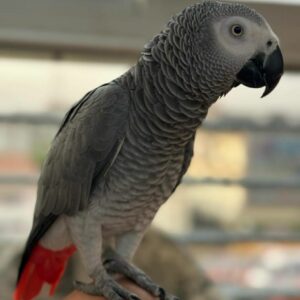Red Factor African Grey For Sale
Red Factor African Grey For Sale, we have made it possible for you to be a Proud Owner of the Beautiful Red Factor African Grey’s! They will be available as pets to people all over the world. They’re certainly beautiful and desirable! The Red Factor African Grey will retain always retain their high level of intelligence and exceptional ability to talk just like their natural wild-colored Grey cousins. Red Factor African Grey.
We have been Breeding these birds now for four years. This breeding skill takes hard dedicated work into finding the right birds, and introducing them to each other. Sometimes this process can take years as African Greys do not mature and breed until 5 to 6 years old. We have spent quite a bit of funds, hard work, a lot of time in searching for the right birds to pair up together and that carry the Red Factor Gene.
And most of all, a lot of patience in doing this right. We now have made it possible to bring you the “Worlds Red Factor African Grey” We also sell Red Factor breeding pairs, and specialize in African Grey Congos and Timnehs that carry a heavy Red Factor Gene. These Exotics are not cheap, as way too much goes into, studying, and obtaining these Rare and Exotic birds which is very time consuming.
The Red Factor African Grey will always retain their high level of intelligence and exceptional ability to talk just like their natural wild-colored Grey cousins.
Care and feeding of Red Factor African Grey For Sale
In the wild the African Grey Parrots eats seeds, nuts, fruits, and leafy vegetation. These birds will climb around the tree, rather than flying, picking up food and holding it with a foot while eating. They enjoy eating the outer flesh of the oil-palm nut, and have been observed eating snails. In West Africa, with a fondness for grains, it is said they have become rather bold pests attacking the maize fields.
Foods for your pet bird will include a ready made large hookbill seed mix enriched with vitamins. Their dietary requirements include sources of calcium and Vitamin A. They eat a variety of sprouts, seeds, nuts, fruits, vegetables, commercial pellets, as well as the same nutritional foods humans eat. A cuttle bone or a calcium block is a good source of calcium.
African Greys should not be fed a diet that is high in fat and protein. A lean diet is recommended as recent studies have indicated heart disease and arteriosclerosis occurring in Greys in their late teens and twenties.
*Fresh vegetables you can offer include mustard greens, green peas, cucumber, young dandelion greens, sweet corn, beet greens, carrots, broccoli, unsprayed lettuce, chickweed, dandelions, eggplant, green peppers, sorrel, spinach leaves, tomatoes and zucchini.
*Fruits that you can offer include, apples, peaches, apricots, bananas, pears, plums, raisons, and most other fruits.
*Avocado and chocolate are considered toxic for birds and sugar and salt should be avoided.
Most parrots enjoy and occasional shower or bath. A shower can be accomplished with either a hand held shower sprayer or a hose with a fine spray head and lukewarm water. A bath pan or ceramic dish 12″-14″ (30-35 cm) can be placed on the bottom of the cage or mounted at about 39″ (1m) above the floor in an aviary.
The wings of parrots should be kept trim if you want to discourage flight and to prevent the loss of your pet through an open window or door. However you must take care to only trim a few (3-5) feathers because this is a heavy bodied bird, and can be hurt if it falls while taking short flights. The beak and claws need to be trimmed if they are not worn down from climbing and chewing.






